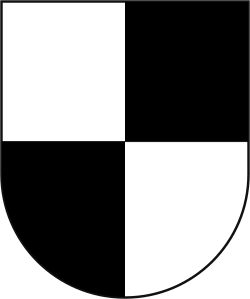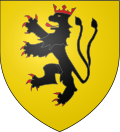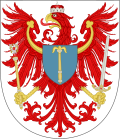Hohenzollern
The Hohenzollern family ruled various territories in and near modern Germany, and later of all Germany. The Royal House of Hohenzollern began ruling the area around Berlin and Brandenburg, now in Germany, in 1415.[1]
| House of Hohenzollern | |
|---|---|
 | |
| Country | Germany, Romania |
| Etymology | Hohenzollern Castle |
| Founded | Before 1061 |
| Founder | Burkhard I, Lord of Zollern |
| Current head |
|
| Final ruler |
|
| Titles |
|
| Estate(s) | Germany, Prussia, Romania, Russia |
| Deposition |
|
| Cadet branches | |
The family became one of the electors of the Holy Roman Emperor and then were kings of Prussia in 1702 and German emperors in 1871.
It stopped ruling after World War I, when Germany became a republic. Prussia was abolished by the four Alliea that controlled Germany in 1947.
The family took it name from its ancestral home, Hohenzollern Castle, in what is now Baden-Württemberg, Germany. The area around the castle was once ruled as a separate principality.
Hohenzollern Media
Alpirsbach Abbey, founded by the Hohenzollerns in 1095
Region of Nuremberg, Ansbach, Kulmbach and Bayreuth (Franconia)
References
- ↑ Hall (trans), Colkin (2005). The Electors of Brandenburg, Kings of Prussia, German Kaisers. Karwe, Germany: Edition Rieger. p. 36. ISBN 3935231644.
Other websites
| Wikimedia Commons has media related to Lua error in Module:Commons_link at line 62: attempt to index field 'wikibase' (a nil value).. |










